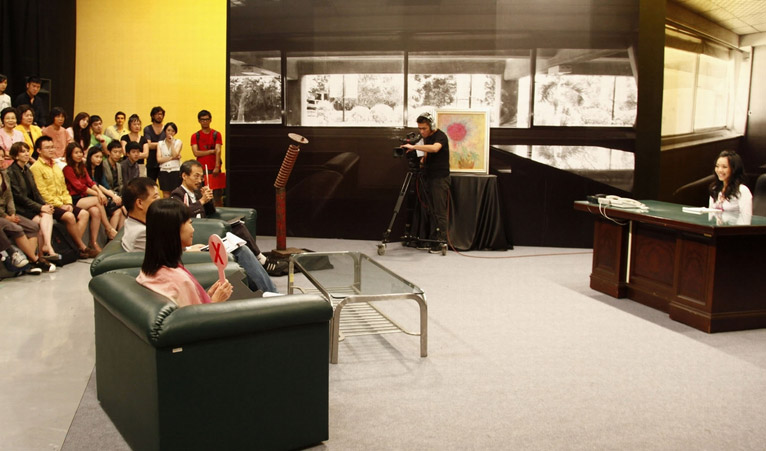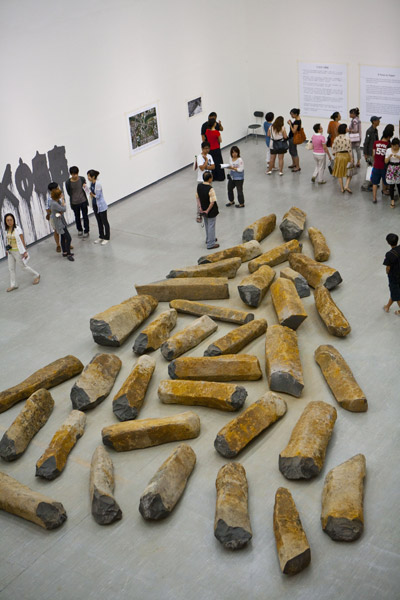2010 TAIPEI BIENNIAL
| December 1, 2010 | Post In LEAP 6

Carrying on a tradition established in its previous edition, the 2010 Taipei Biennial does not have a set exhibition title. This does not mean, however, that it does not have a theme. In the exhibition text, “Curatorial Discourse,” featured curators Tirdad Zolghadr (1973-) and Hongjohn Lin (1964-) call attention to two issues that are central to the exhibition: “rethinking the meaning of ‘Biennial’ itself” and “the politics of art.”
Based on the design of the Taipei Fine Arts Museum exhibition and the myriad events, lectures, satellite projects, and related programs that these two curators have organized, it is evident that they no longer regard the Biennial merely as a venue for the exhibition of artists and their works. Instead, they are much more interested in viewing and problematizing the Biennial as a “mechanism;” it has become a text, and the curators are interested in the science of its performed politics. Hongjohn Lin and Tirdad Zolghadr have each respectively referred to the Biennial as a mechanism of performance; their shared point of concern: how might this mechanism sufficiently provide a new, “self-reflexive” perspective?
The 2010 Biennial is distinct in that it has specially invited back artists from the 2008 Taipei Biennial, with the intent of “reviewing works that have previously participated in the exhibition with a fresh, critical eye” (Zolghadr, “Curatorial Discourse”). The repeat invitee list has only foreign artists and no local ones; it is hard to understand what major considerations went into this choice. Furthermore, Zolghadr’s so-called “fresh, critical eye” comes across as a rather evasive use of language, in that the artists who were invited back have simply returned with the same concepts and applied them in basically the same way, with slight modifications. The return of many previous participants’ work also gives this exhibition the appearance of a sequel to the last one; the record number of forty-seven artists (and groups) included in the previous edition has been reduced to twenty-four artists this time around. Broadly speaking, in the artist choices as in the curatorial premise, a sense of repetition overwhelms that of continuity.

The 2008 curators were Vasif Kortun (1958-) and Manray Hsu (1958-). Kortun came to the Taipei Biennial equipped with an abundance of experience from his involvement in the Istanbul Biennial, as well as an in-depth understanding of the international scene. Under his influence, the 2008 Taipei Biennial broke out from the limiting construct of the museum as sole venue. Kortun re-contextualized the museum, proposing the concept of interconnection: his was a new exhibition model in which the museum was the hub of the Biennial, but was no longer the whole event. Starting from this hub and moving outwards, the curators attempted to stretch, situating works in public spaces where crowds would assemble in order to form a more flexible exhibition network. The idea of network expansion, a conceptual microcosm of the interconnectedness behind globalization, was the driving force behind the project.
It is obvious that Kortun’s approach was a model for Zolghadr (besides, both have taught at Bard College’s Center for Curatorial Studies). Indeed, Zolghadr and Hongjohn Lin have in many ways followed suit: they have moved forward with the notion of the “museum as a link in the Biennial chain;” they have more actively utilized “satellite projects and related programs” which incorporate alternative art spaces; and they have attempted to expand the Biennial into a forum and educational space. Their treatment of exhibition technology also goes one step further: they have converted the gallery into a social space, allowing systemic social reality to infiltrate the artists’ displays as they voice their own systemic critiques. This kind of approach is what curators mean when they emphasize the “critical consciousness” of “self-reflexivity.” In his text, Lin discloses that the adoption of this technique is an outgrowth of the Frankfurt School’s position on criticality, as well as representative of the curators’ decision to take this opportunity to review, from a critical standpoint, the whole of “artistic production.”

So, has the 2010 Taipei Biennial fulfilled the expectations set by its curators? If any, they certainly have transformed the museum space. As a result, all manner of contemporary realities—meriting critique and sometimes even arousing disgust—have manifested themselves throughout the course of the exhibition and have undergone much discussion. But what happens when artists play the role of political and social reformers, and when art is dragged into conflict with the relationship between aesthetics and politics? The vast majority of viewers anticipating an upcoming visit to the museum inevitably ask, “At the point when aesthetics have become a secondary matter, and art has become a first-hand tool of political and social reform, why do we—we whose origins are, in the first place, in society at large—even need to walk into the museum today?”
The exhibition has been successfully shaped into an object of speculation; the curators have welcomed a multitude of artists’ critiques and inquiries regarding the structure and function of the museum. And yet, herein lies the true paradox: although the museum seems to be able to tolerate all manner of criticism from the art world as long as it dons the hat of “voice of the Biennial,” what happens when it must assume its duties as an official institution, and one backed by a deeply rigid bureaucracy? Can it continue to be truly “self-reflexive”? German artist Christian Jankowski’s video, Director’s Cut, best embodies this conundrum. Featured in the exhibition, the parody takes its inspiration from a nonfictional situation: the Taipei Fine Arts Museum’s recent postponement in filling a vacancy in the position of director. The artist hosts a game-show in which contestants vie for the position of new museum director. Ironically, while the film was being shot, the new director had already been unofficially selected by the Cultural Affairs Bureau. Even more ironically, just one week after the opening of the exhibition, the appointee, a university architecture professor without much understanding of contemporary art, or of the contemporary art community, quickly took up his new post.
In the end, is the Biennial just some kind of “carnival,” a ship that comes and goes, leaving no trace on the water, no ripples in its wake? With their thesis on “self-reflexivity” in mind, the two curators specially planned for several commercial galleries to set up booths throughout the museum, with the intention of investigating the relationship between artistic production and commercial industry. However, the gesture seems to work only on the surface level, as people do not seem to be willing to genuinely believe that participating galleries will attain any kind of “self-reflexivity” out of the exercise. As at other moments in this biennial, the art is marginalized, transformed into one big, eloquent mouthful of a dissertation; the true artists are now the curators themselves, and the true works on display are the curators’ footnotes, illustrations, and board-game pieces. Jason Chia-Chi Wang

